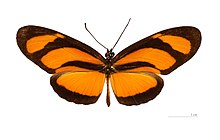| Lybia longwing | |
|---|---|
 | |
| Dorsal view | |
 | |
| Ventral view | |
| Scientific classification | |
| Domain: | Eukaryota |
| Kingdom: | Animalia |
| Phylum: | Arthropoda |
| Class: | Insecta |
| Order: | Lepidoptera |
| Family: | Nymphalidae |
| Genus: | Eueides |
| Species: | E. lybia |
| Binomial name | |
| Eueides lybia (Fabricius, 1775) | |
| Synonyms | |
| |
Eueides lybia, the lybia longwing, is a butterfly of the family Nymphalidae. It was described by Johan Christian Fabricius in 1775. It is found from Central America to northern South America, [1] from Nicaragua to Bolivia. [2]